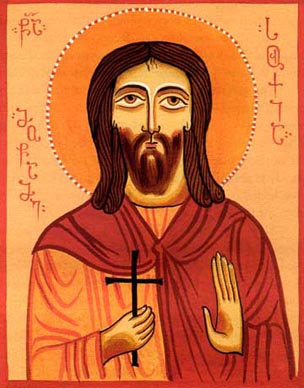
The Holy Martyr Sukhios and his 16 Gruzian (Georgian) Companions
Commemorated on April 15
The Holy Martyr
Sukhios and his 16 Gruzian (Georgian) Companions were illustrious
dignitaries who served at the court of the Albanian (Hagbanite) ruler (i.e.
"Caucasian Albania" – a realm on the present day territory of
Azerbaizhan).
Escorting the
Albanian ruler's daughter Satenika, spouse of the Armenian emperor Artaxar
(88-123), Saint Sukhios and his 16 Companions arrived in Artashat, the ancient
capital of Armenia (the city was later destroyed by the Romans in the year
163). Preaching there at the time was the Greek Christian named Chrysos, who
had been enlightened and ordained by the holy Disciple Thaddeus (+ c. 44, Comm.
21 August). The dignitaries came to believe in Christ the Saviour, and they
firmly resolved to devote all their life to the service of God. All seventeen
of the newly-converted Gruzianians followed Chrysos into Mesopotamia. At the
time of their Baptism in the waters of the Euphrates, made over them by Bishop
Chrysos, they were vouchsafed to behold the Lord of Glory Jesus Christ.

At the place of their
Baptism, the holy martyrs erected a venerable cross and named it the
"Cross of the Annunciation". Bishop Chrysos at the Baptism gave all
the saints new names: to the eldest – Sukhios (replacing his old name
Bagadras), and to his companions the names – Andrew, Anastasias, Talale,
Theodorites, Juhirodion, Jordan, Kondrates, Lukian, Mimnenos, Nerangios,
Polyeuktos, James, Phoki, Domentian, Victor and Zosima.
After the martyr's
death of Blessed Chrysos, Saint Sukhios became the spiritual leader of the
brethren. All soon resettled in a wild locality on Mount Sukaketi, not far from
the mountain village of Bagrevandi. Here the former dignitaries led very strict
ascetic lives, the scant mountain vegetation sufficed them for food, and for
drink – a cold spring of water.
The new ruler of
pagan Albania, Datianos, learned of this, that his former officials had
accepted Christianity and had gone off into prayerful solitude. He commissioned
his associate Barnapas with a detachment of soldiers to persuade them to return
to court and return also to their former faith. Barnapas searched out Saint
Sukhios and his companions, but in keeping of their vow of service to God, they
refused all the entreaties.
Then by order of
Barnapas, Saint Sukhios and his companions in cross-like form were nailed to
the ground and consigned to burning. After the burning, their bodies were
dismembered and scattered all about Mount Sukaketi, from which the martyrs
received also the title the "Mesukevians" (more correctly –
"Sukaketians"). This occurred in the year 123 (by another account –
in the year 130; although an Athos parchment manuscript of the XI Century from
the Iveria monastery indicates the year as 100).
The holy remains of
the martyrs remained undecayed and unburied until the time of the IV Century,
when they were placed in graves and consigned to earth by local Christians (the
names of the holy martyrs were found written on a cliff).
The holy PriestMartyr
Gregory, Enlightener of Armenia (+ c. 335, Comm. 30 September), built a
church on this spot and established a monastery. And afterwards, a curative
spring of water was discovered there.
© 1996-2001 by translator Fr. S. Janos.